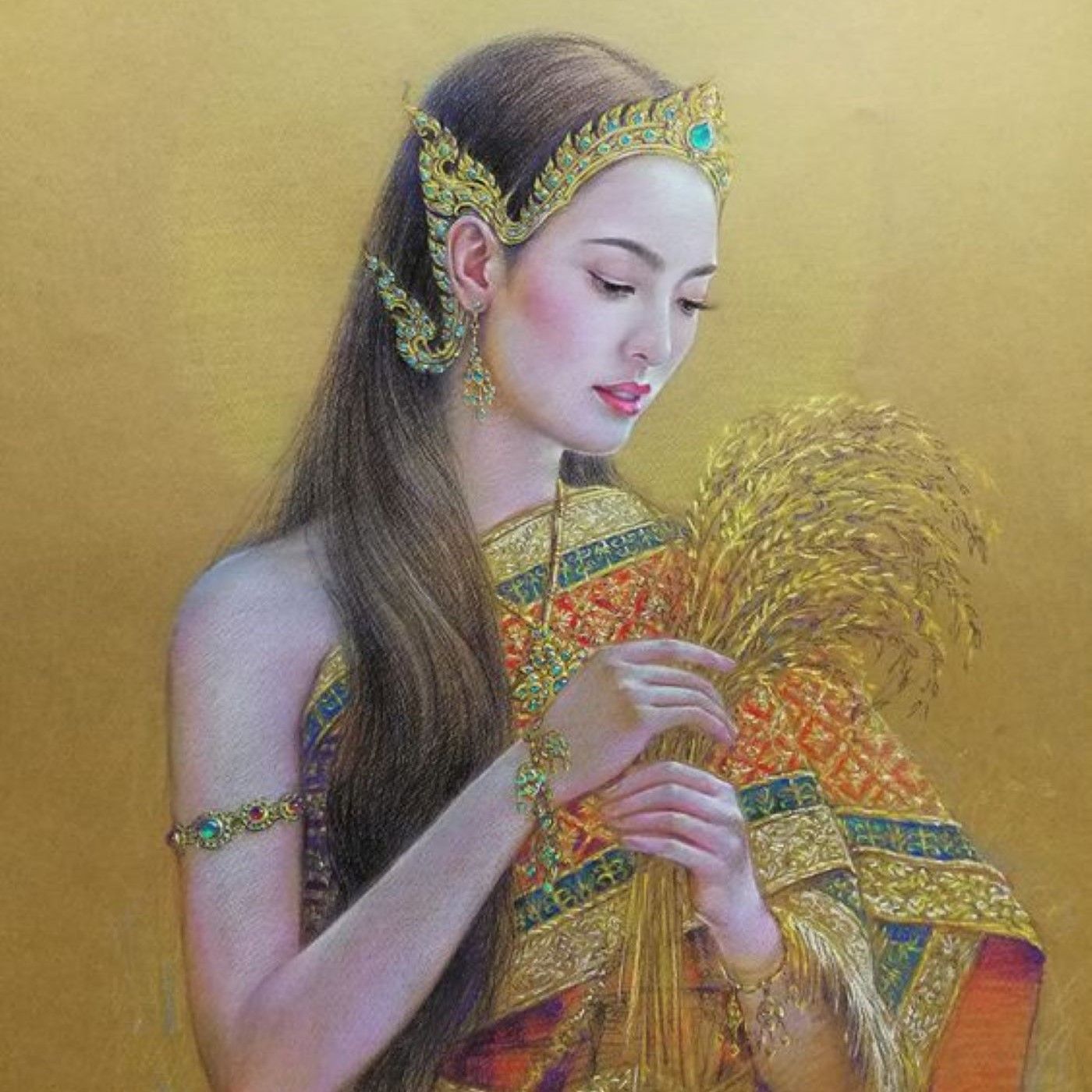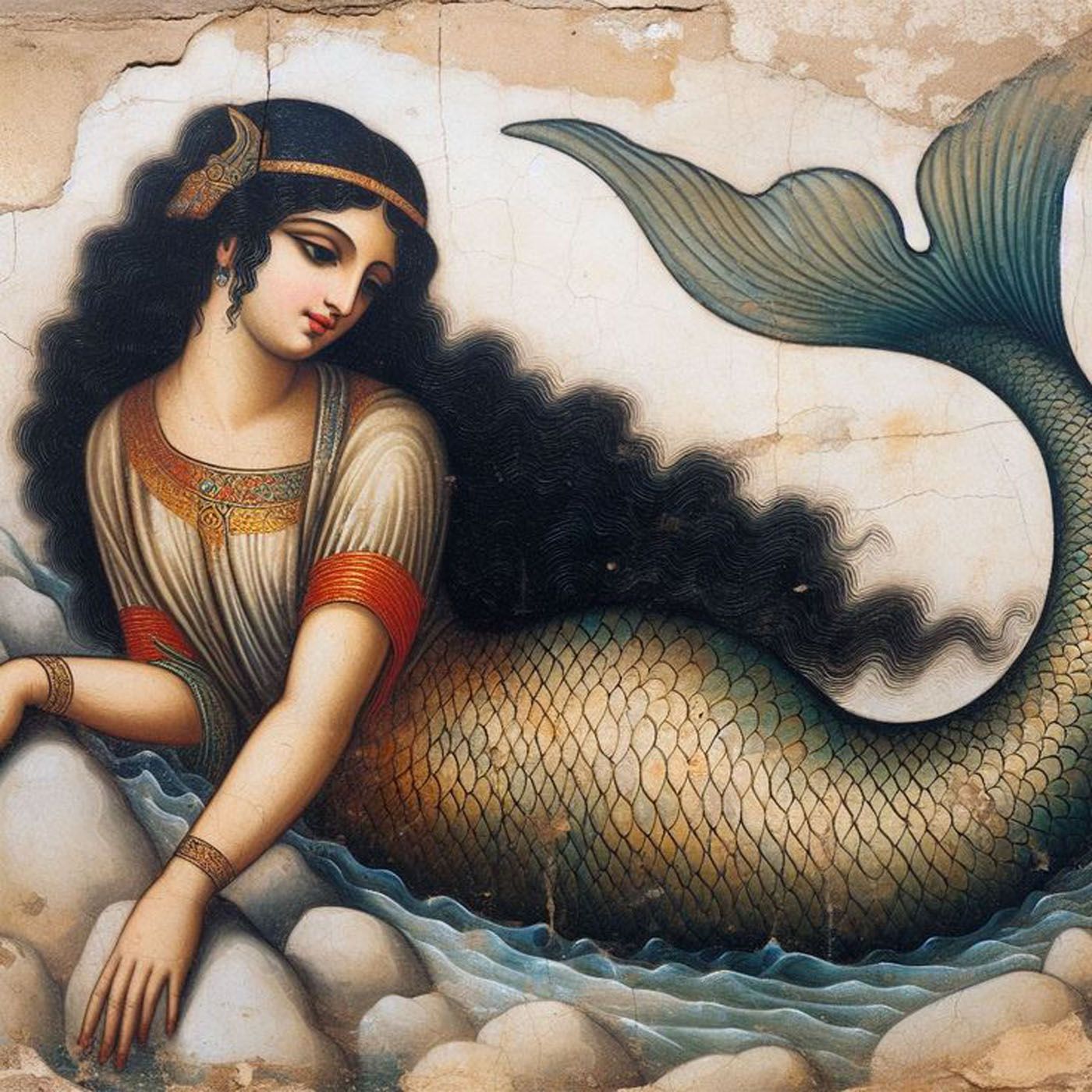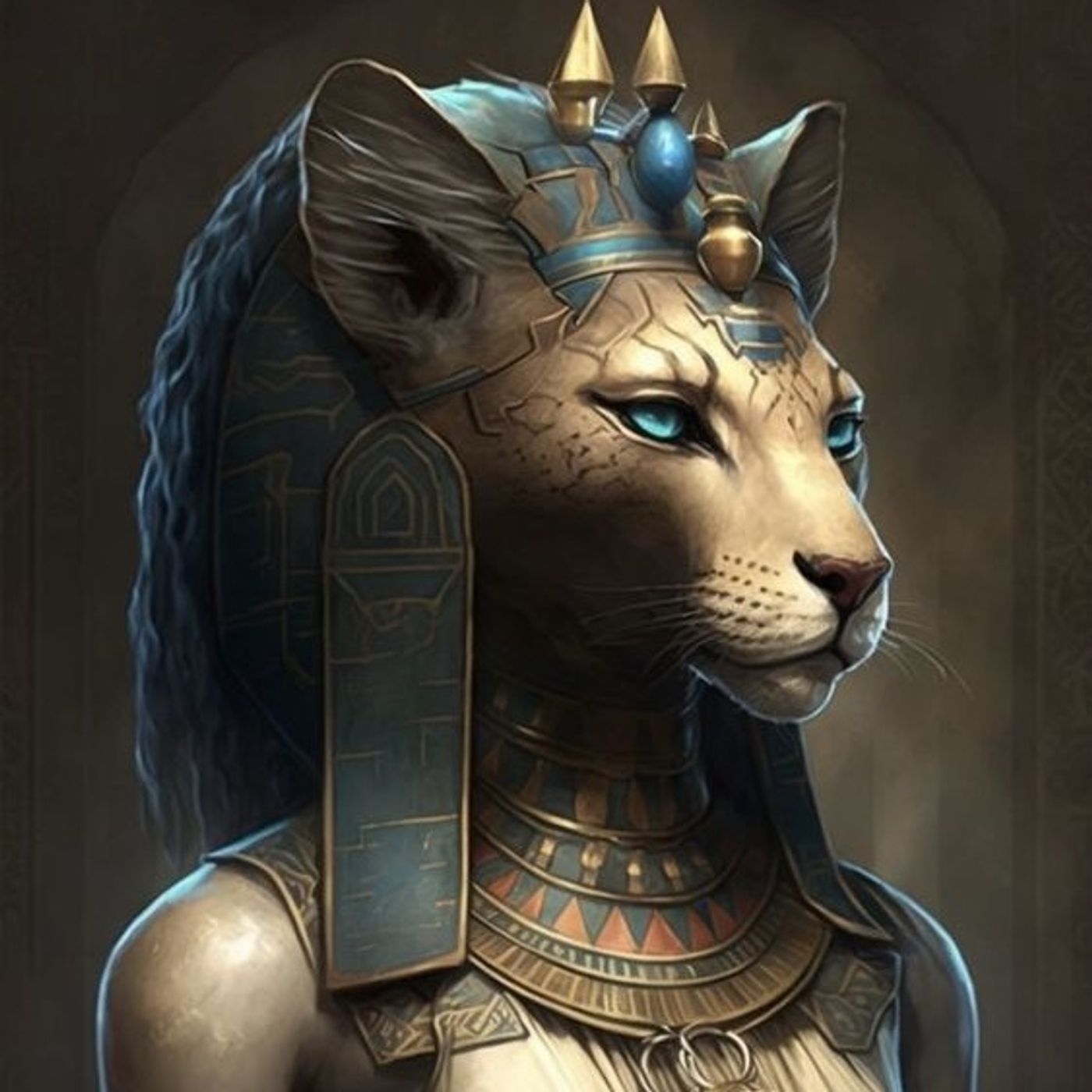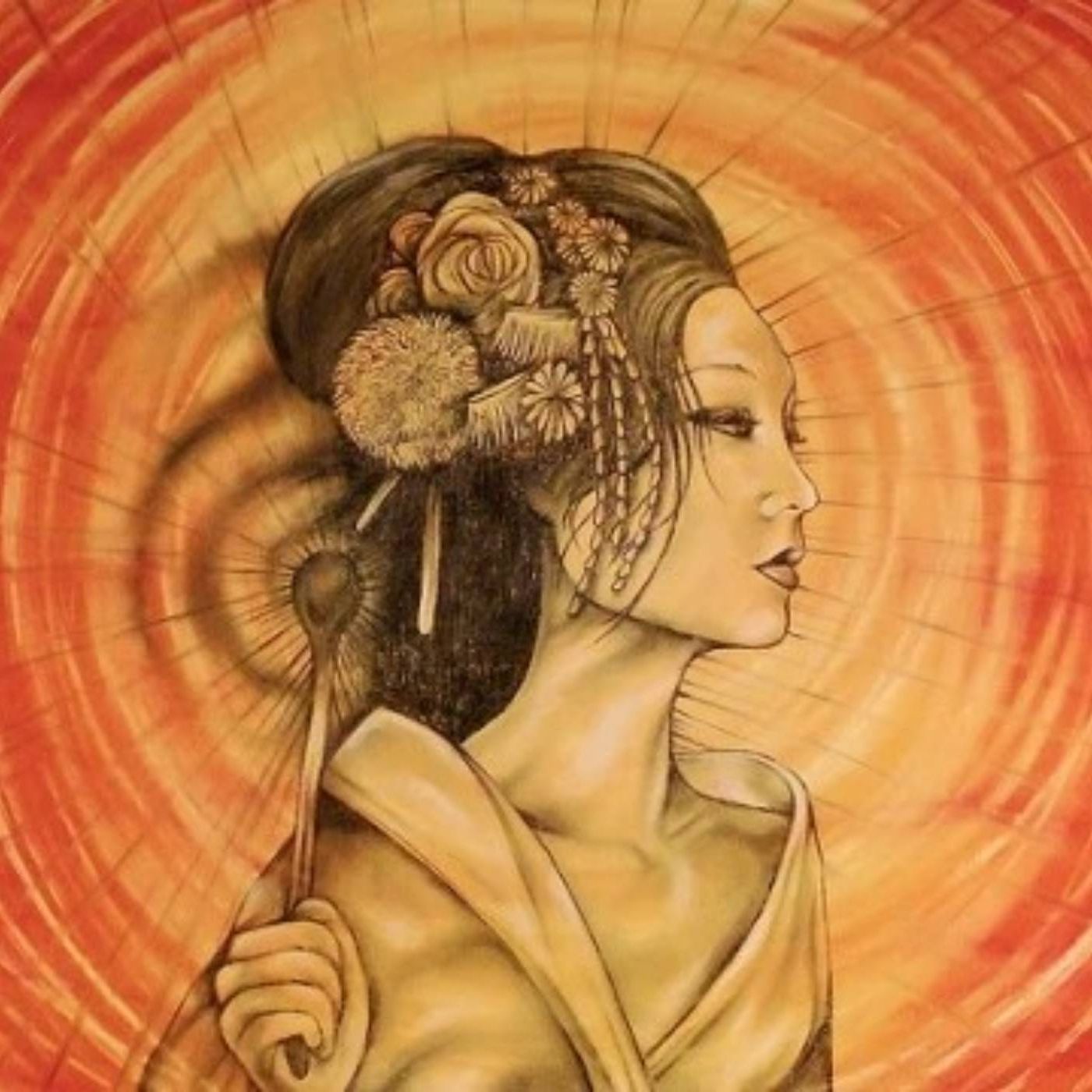Show Notes
Isis’ story embodies themes of compassion, healing, rebirth and magic. Her traditional name in Egyptian is actually Aset, but she became Isis through Greek influence in later history. In fact the name Egypt is also Greek in origin and the land was originally known as Kemet.
While there were holy mothers before Isis, such as Inanna, it was Isis who would shape iconography and mythology for all holy mothers who followed. In particular you can see so many parallels within the Christian stories of Mother Mary and the Holy Family.
Even with these overlapping influences, her story still stands alone in majesty and power.
Show Transcript
Her story begins at the dawn of creation.
Once there was nothing but a vast ocean with a dark sky above, until from this blackness emerged a small mountain upon which stood Atum, the first God and the one through who the Sun would radiate light.
Though this first God was complete and whole within themselves they ached for more. Atum wished to see his existence expand and for the void around him to become full of life. This longing became what we would call loneliness. As he yearned for another to be with him, he saw a figure upon the small mound that he inhabited. Alas it was not another being such as he, but merely his shadow. However, for Atum this was more than enough to begin with.
The dark form that was birthed from his light was beautiful and together they would create even more. So it was that Atum and his shadow birthed two children: Shu and Tefnut. Shu embodied the masculine and Atum bestowed his son the dominion of air, while Tefnut, the feminine, would hold reign over moisture.
Shu and Tefnut delighted in their birth but even more so in the creativity that was within them. They went out into the void to create the world. Once more Atum was alone and having known the joy of children beside him the yearning for them was even deeper than before when he was alone.
Atum plucked one of his eyes from his face and sent it out to look for his children. When that eye arrived to where Shu and Tefnut were, they realised just how much their father not only missed them but how much they were loved.
They returned immediately to Atum, handing him back his eye and then telling him of the world they had created. Atum was so overcome with joy at their return as well as the news of their creation that he wept tears of pure joy. As his tears landed upon the mound, they in turn created the people to inhabit this new world.
While Shu and Tefnut had been away from Atum they had also birthed two new Gods: Geb and Nut. Geb was the God of Earth while Nut was the Goddess of the Skies. The new Gods revelled in a world that was newly born. Their lives became intertwined much like that of lovers and they would find every opportunity they could to embrace one another, such that the sky was constantly falling to the ground.
This angered Atum, for their behaviour was constantly undoing all that Shu and Tefnut had created. So the first God, over seer of all, pushed the two apart and fixed Nut into the heavens so that although she could still look upon him, she would never embrace Geb again.
Before Atum could separate them, Geb and Nut created four children; The first of these was a son, Osiris, and as the eldest son he would be king of the world, becoming the first Pharaoh. Osiris embodied truth, justice and knowledge.
Second was a daughter, Isis, who embodied magic and healing, for she knew the mysteries of the world and how to harness its powers.
Isis would become wife and queen to Osiris and together they upheld Ma’at; the energy of harmony and flow that ensured a life of ease, grace and abundance.
Third was another son, Set, and he would be the counterpart of Osiris. Set was not inherently evil but ruled over the energies of war, chaos and storms.
Fourth was a second daughter, Nephthys, the compliment to her sister Isis, embodying the same energies of motherhood and protection. She would become Set’s wife and be the balance to his more chaotic energies.
From these four gods all other gods and goddesses would be born.
For a time, the rule of Osiris was blessed with the peace and harmony that he sought for the world around him and those he reigned over revered him with both respect and love. However, there was one within his kingdom who thought otherwise.
Set grew more jealous as each day passed. He watched his brother upon his throne, casting proclamations and guiding his people. All Set could think was, that but for the timing of his birth it would have been himself in that place and his voice calling out to all in the realm. If only something should happen to his brother, then Set could take his place. This last thought festered within Set’s mind until it transformed from possibility into a solid plan.
Set snuck into Osiris’ chambers one night as his brother slept. He quietly measured the length and width of his brother’s body. The next day he went to a carpenter and asked that the man make for him a casket of these dimensions. When it was complete, he then gilded it with the finest of gold and inlaid precious gems along its surface.
With the casket sitting within his home, the envious brother invited the Pharoah Osiris to attend a banquet there. It was a grand gathering and having the king there made it even more so. After they feasted and drank Set stood and announced that he had a wonderful game for all to play. He explained that he had a magnificent gold box and the one who could fit in it perfectly would become its owner.
One by one the men attending the party took their turn to lie within the gilded casket, but of course none matched its proportions. Then Osiris stepped forward and lay within it. As he rested back into its perfect shape for him, Set and his men rushed forward, pushing the lid in place and nailing it shut.
This all occurred with such speed that by the time people realised what had occurred, Set and the men had carried the casket out to the Nile River and thrown Osiris, trapped within it, into the fast-flowing waters.
When Isis and her maids finally released what had happened and rushed to the river, Osiris within the casket was long gone. Isis cried out in agony so that her voice was heard across the ancient land. Then she gathered herself and followed the river, determined to find her husband.
As she travelled along she asked every person she came across if they had seen the casket. They would all nod and tell that it had passed some time ago. So, Isis continued her search.
Eventually she came to where the river met the sea and still no sign of Osiris could be found. As she sat upon the shore and wept, a fishing boat landed near her.
Once more she asked, “Have you seen a gold casket within the water?”
The fishermen nodded and told the Queen that indeed they had passed it with their boat, and it had been floating towards the town of Byblos. When Isis explained that it contained their Pharoah, the men took her aboard and turned their boat to make the same journey as Osiris.
When Osiris within the gold chest had washed upon the shores at Byblos, he had lodged within the sands at the base of a tamarisk tree. The tree emboldened by the divine powers of the God had a sudden surge in growth. As it began to enlarge it lifted the casket up and soon the thickening trunk wrapped around the box entombing the Pharoah within, and it was here that he would take his final breath.
When King Malacander heard of this miraculous tree he made way to the seaside to see it, with his Queen Astarte by his side. Looking upon the tree, unaware of who was enclosed within, he was overcome by its magnificence and ordered the tree trunk be taken to the palace. Here it would be used as a pillar within his private quarters, so that he could look upon it each day within the safety of the palace.
So when Isis arrived upon the shore Osiris had long been taken away. Some children were playing by the sea and Isis, now disguised as an old woman, asked them if they had seen the casket. They told her that they had seen it some days before and pointed to the place where now there was only the stump of the tamarisk.
Isis sat by the stump and could see the wood had not long been cut. Just as she wondered about this, three young women came to bathe in the water. They were hand maids to Queen Astarte and when they saw Isis they were intrigued by her clothes and hair, realising that she was from another land and not from their home here in Phoenicia.
They approached who they thought was simply an old woman and made conversation about what she was wearing and how she braided her hair. Isis in turn offered to brush and plait their hair when they finished bathing. As she did so she asked about the recently cut tree and the women told her the story of the sudden growth of the tamarisk and how the tree was now part of the palace. Isis knew immediately that it had been Osiris that had affected the tree and was sure that he was within the pillar now holding up the palace roof. She continued plaiting their hair and as she did so, Isis infused them with a perfume like nothing else within the lands of Phoenicia.
When the maids returned to the palace Astarte was intrigued by the styling of their hair, and as the women shared about who they met, their perfume wrapped around the queen. Fascinated by the story of this curious woman, Astarte told the maids to bring her to the palace.
As Isis walked with the maids to the palace her heart began to beat rapidly. She prayed to Atum, her grandfather, to let Osiris be found so that his body could return to Kemet for a proper burial. When she sat before the Queen, the goddess created her story as that of an old woman making way to find a new home.
Astarte could sense the pure heart of the old woman and offered that she might stay in the palace and help care for the young princes; in particular, the youngest, Prince Dictys, who had been ill for many months now. This Isis agreed to, for it would mean she could be close to Osiris’ remains until she found the way to return with him to Kemet.
Isis quickly became a highly trusted member of the royal household. Even with her personal agenda, the goddess was a devoted carer to the young princes, and she restored the health of Dictys so that he was once more a healthy young boy. Her affections for him became so deep that Isis decided to grant the prince immortality. She would do this by burning away his mortal energies, literally placing him into a fire.
Just as Isis was beginning this process Queen Astarte happened upon them and saw her son being put into the flames. She screamed and ran to pull him away from the woman and what she thought was sure to be her son’s death. Isis stepped away from the child and rose into the air, taking the form of a swallow, circling over the Queen as she cradled her son.
When Astarte saw her son was in no way harmed, she calmed herself and looked up at the swallow still circling. It was then that Isis once more transformed. This time she took her true form and stood before the Queen as the grand goddess that she was.
As Astarte looked at Isis in complete awe, she realised that the goddess energies of Isis had been within the palace the whole time her new maid had been there. Here before her was the reason her young son was now thriving and what she had just witnessed would have been yet another miracle bestowed by the goddess. The Queen now bowed before Isis offering her utmost obedience as thanks for all she had done.
Isis touched the Queen’s head and told her that there was only one thing she wanted in return for all she had done. The Goddess asked she be given the wooden pillar taken from the shore.
This wish was granted immediately, and the King and Queen stood by as Isis commanded the wooden pillar to split open, revealing the embellished casket within. Isis opened the box and once more looked upon the face of her beloved Osiris, now still and lifeless.
The King arranged for a boat to carry the Pharoah and Isis back to their homeland. Once there Isis took Osiris’ body deep into the reeds along the banks of the Nile, where she could hide him from Set. Then Isis began to gather the herbs needed for his funeral rites.
However, word soon reached Set that Isis had found their brother’s body and returned him home. While Isis was gathering her herbs, he sent his men to search for the dead Pharoah’s body and they found Osiris tucked away in the tall grasses. Set now furious took to Osiris’ body with a sword, cutting it into dozens of pieces. He then hurled each part into different regions of the land, sure that now Osiris could never be found again.
Set’s fury in doing this was matched by Isis’ renewed grief when Set told her what he had done. Isis looked to heavens and lifted her arms. From her body grew wings and once more the Goddess took the form of a bird. This time it was not the small gentle sparrow. Instead, she took to the sky as a powerful kite.
As she soared the sky she called to her sister Nephthys. She too became a kite and together the sisters flew across all the land, gathering the dismembered parts of Osiris. When they had gathered all the parts they returned to the land and their human form. Then taking bandages they bound Osiris back together. However, they were missing one part- his penis.
The sisters worked together calling upon all the Gods and Goddesses to restore breath into Osiris and this they granted to the true king. When Osiris’ heart was once more beating and his lungs filled and emptied as they should, Isis was overcome with joy. Now Osiris could once more take his rightful place upon the throne. Osiris though knew this could not happen with a body that was incomplete. Despite his resurrection he would now have to continue into the afterlife.
Before he could leave the Earth realm Isis once more let her wings spread from her body. She then flew in circles around Osiris, faster and faster, drawing from him the essence of his seed, pulling it into her womb and impregnating herself with his child. Then she stood before him and they had one more embrace before Osiris, the first Pharoah, left to rule over the underworld.
When Set heard that Osiris was now completely gone from his realm he breathed a sigh of relief; not only that his rule was secure, but that Isis would have no male counterpart to threaten him either. To Set, Isis was now merely another priestess performing prayers and rites. She could never be a threat to him. Soon Set would even forget about his sister completely.
This dismissal of the Goddess allowed her pregnancy to progress with no interference and Isis would give birth to a son that she would name Horus. No matter that Isis was seen as being no threat, her son, and true heir to the throne would indeed be seen as one. So Isis did all that she could to hide his very existence from Set.
Isis kept him hidden amongst the grasses along the great river’s shores, only leaving him to collect food. Together they were protected by seven scorpions. When Isis would venture from the hidden home, the scorpions would escort her; three would lead the way, one would be on either side of her and the two fiercest would walk behind.
One day Isis ventured into a village to ask for food. When she did this the Goddess would disguise herself as an old woman so that Set would not hear of her travels and find her location. On this occasion she approached the home of a wealthy woman who bluntly refused the old woman’s request, adding an insult to accentuate her distaste at being asked.
Isis with her infinite compassion, simply nodded and walked on. She held no ill feelings for the woman and soon another home, although much poorer, offered her the goods she needed to feed her son. The scorpions though were not so forgiving. As Isis walked on, the two most brutal of her guards remained and stung the young son of the wealthy woman.
The Goddess heard the cries of the woman and rushed back to the house, finding the woman holding her son and crying hysterically. Isis fell back into her true form and placing her hands upon the boy, she demanded that the poison leave his body. The boy’s fever broke, his breath slowed and the wound from the scorpion stings healed over. Soon it was as though he had never been stung.
The wealthy woman begged the Goddess to forgive her. To prove her remorse she took her purse and gifted a generous amount to the poor woman’s home that had cared for Isis.
Isis continued to keep Horus safe until he grew to become a man. Now after all these years of hearing how is uncle had betrayed his father and wrongfully claimed the throne, Horus was ready to confront Set.
With the strength of Osiris within him, the unconditional love of Isis and the blessings of all the Gods and Goddesses before him, Horus faced Set in direct battle and easily defeated him. Set, now crushed, was cast from the kingdom, and never seen again.
Horus would now sit upon the throne that was taken from Osiris and under his rule, with guidance from Isis, the grace of Ma’at would be restored to the ancient land and its people.
As the mother of this now true Pharoah, Isis would be known as the mother of every Pharoah to follow her son. Each King would be seen as the embodiment of Horus, then upon their death becoming Osiris in the afterlife. Isis would greet them in the underworld, resurrecting them as she had her beloved, so their soul could journey on. With her infinite compassion she would do this also for every soul upon their death and ensure their eternal life.
Isis remains within the realms of Earth as an immortal being. She takes her form as a kite to watch upon all, guiding boats and offering protection to those on land. The great mother hears prayers of the ill and sends healing, and watches over every birth to strengthen mothers.
Her grand energies were so beloved through the ages that even as the worship of the old gods made way for the new, her story blended into the new worship and every holy mother who followed. Isis temples still stand thousands of years later to remind all that her love and magic is truly eternal.
Listen to the audio of this story at
https://www.spreaker.com/user/8255993/isis
©2021 Marisa Calvi
Translations and sharing are allowed
if no fee is charged and that proper credit is given to its source.
Listen On
Also Listen
-

Dewi Sri - The Rice Goddess
Dewi Sri is not your usual goddess of grain and harvest. Born as a gift to the K -

Atargatis - The First Mermaid
The powerful emotions of human life can lead to great transformations. Atargatis -

Sekhmet - The Lioness of Balance
The world and it's people live in a balance that is both fragile and all encompa -

Amaterasu -The Goddess of Light
Amaterasu is the Japanese Goddess of Light. When Amaterasu is grief stricken and

